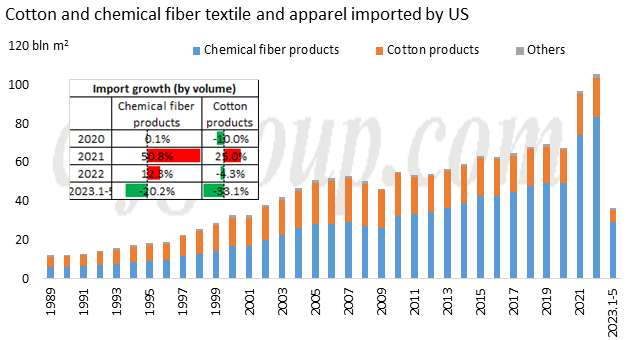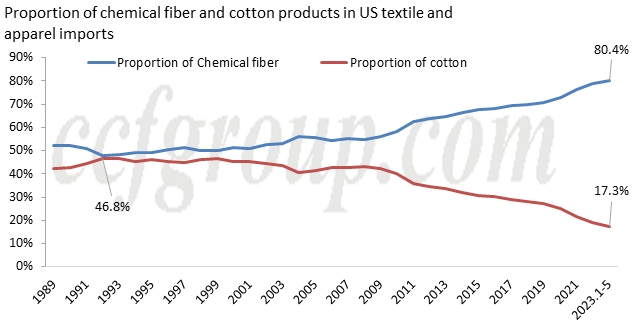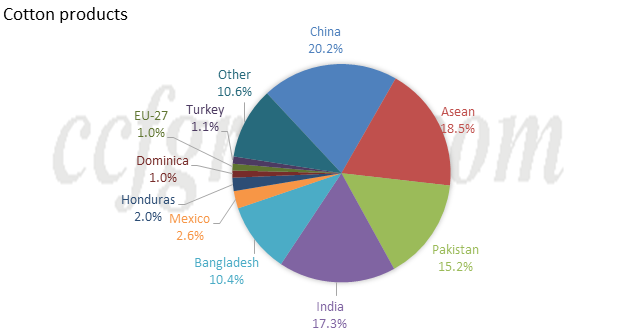Name:HENAN GUANGDA TEXTILES IMP. & EXP. CO., LTD.
Add:10/F,XinMangGuo Building,No.9 Business Outer Ring Road,ZhengDong New District,ZhengZhou,China
Tel:86-371-60170260
Fax:0371-60136222
Postcode:450000
Web:www.hngdtex.com
As of May, textile and apparel imports in the United States remains weak, with a cumulative year-on-year decline of 22.2% in the first five months. Among them, imports from China decreased by 27.2% compared to the same period last year, and a turning point has not yet emerged. The weakened demand for textile and apparel imports in the United States is due to several factors. Firstly, wholesalers and retailers in US still have relatively high inventory and have not completed destocking, which diminishes the motivation for restocking. Secondly, the United States is in a period of inflation and interest rate hikes, leading to a decline in domestic consumption capacity for textile and apparel compared to previous years. Amidst the subdued demand for textile and apparel imports in the United States, what are the differences between cotton and chemical fiber categories in import performances?

From the perspective of the importation of cotton and chemical fiber textile and apparel in the United States over the years, it can be seen that the growth of chemical fiber products has been more pronounced, especially during the period of 2021-2022. While the demand for cotton products has remained relatively stable. This has resulted in a gradual decline in the market share of cotton textile and apparel in the US import market. As of May this year, 80% of textile and apparel imports in the United States were chemical fiber products, while only 17.4% were cotton textile and apparel. In comparison, cotton accounted for 40% of textile and apparel imports in 2010.

So, where do the United States mainly import cotton and chemical fiber textile and apparel from? As shown in the charts below, the main sources of cotton textile and apparel in the United States are China, ASEAN countries, Pakistan, India, and Bangladesh. These markets account for more than 80% of the total imports, while other markets have relatively lower proportions. Looking at the development trends, China's market share in the U.S. cotton textile and apparel market peaked in 2010 at 36.2% and has gradually declined since then, accelerated by the trade war and the pandemic. On the other hand, ASEAN countries, Pakistan, India, and Bangladesh have seen an increasing share, with ASEAN countries approaching China's proportion. However, apart from India and Pakistan, which have relatively high self-sufficiency in cotton supply, ASEAN countries and Bangladesh have a high dependence on raw material imports. Therefore, the development of ASEAN countries and Bangladesh will also promote the export of textile products of China.
Chart. Main sources of cotton and chemical fiber textile and apparel imports in the United States in Jan-May 2023 (by volume)


The main sources of imports for chemical fiber products in the United States are China, ASEAN countries, Mexico, EU27, Egypt, India, and Turkey. Other markets have relatively smaller proportions, with the above-mentioned markets accounting for 85% of the total imports. China accounted for 30% of the U.S. chemical fiber textile and apparel market, which is significantly higher than other markets. However, this proportion declined by more than 20 percentage points in just a few years, from 55.9% in 2018. Meanwhile, ASEAN countries, EU-27, Mexico, India, Turkey, and Egypt have seen increases in their market shares by 4.6%, 4.8%, 4.7%, 1.8%, 4.6%, and 7.2% respectively. It is evident that other markets have experienced significant development, particularly Egypt, which has shown rapid growth. Currently, the demand for textile and apparel imports in the United States remains sluggish. The share of China's cotton and chemical fiber textile and apparel in its import market have declined to varying degrees. However, the development of alternative markets may present some opportunities for China's textile and apparel industry.